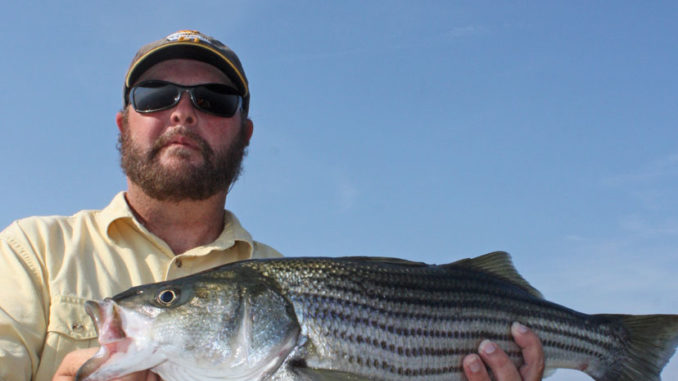
Find a school of hungry stripers, stay on them, and you can have some of the season’s most-exciting action.
“Here they come.”
Those were the only words the anglers aboard Truman Lyon’s boat needed to hear. The 83-year-old striper guide watched as his graph depicted several fish leaving a mass of stripers clustered near the bottom of Lake Moultrie, moving higher in the water column. His vast experience told him this meant rod-bending action was mere moments away.
Four live herring had just been precisely dropped to a specific depth on a mid-May quest for stripers. Lyon had stopped his boat on what appeared to be a cluster of big stripers — or an underwater Volkswagen graveyard, based on the big, inverted marks on the graph.
When the fishy marks on the graph moved up to the level where the baits had been placed, just above the mass of fish, everyone was positioned next to a rod and ready for action.
As Lyon had predicted, the rods started bending, and within a few seconds, all four were three eyes deep in Lake Moultrie. It was fun-filled chaos for two hours until several dozen live herring had been consumed by ravaging striped bass. Even though the fish were in water more than 40 feet deep, the action couldn’t have been faster if it had been topwater schooling fish.
“It’s like this every May,” said Lyon, who has been fishing the Santee Cooper lakes since the 1970s and operates Santee Cooper Charters. “The stripers pile up into Lake Moultrie, and when we get on the right spot, the action is fast and even frantic. Some anglers ask why we only put down about four rigs at a time, but the answer is soon apparent when they realize there isn’t time to manage more than that when the stripers turn on.
“May in 2014 was an awesome month,” he said. “The numbers of stripers are back, there’s no shortage of fish and we now seeing the good results of the size and creel limits. We catch fish on Lake Moultrie all spring, but a lot of the fish do run up the river. By May, huge numbers of stripers return and are looking for something to eat. Knowing where and how to fish in May makes it an extraordinary productive month in terms of predictable patterns and catching both quality and quantity of stripers. It’s not unusual to catch several dozen fish on any given trip, and usually several will be in the 26-inch and above keeper class. But catching and releasing 24- and 25-inch stripers is still a ton of fun.”
Lyon said that fishing in deep water is a key to success for the entire month, and as May progresses, the pattern only gets stronger.
“Sometimes it does take patience to find the big schools of fish, but the positive aspect is that they are often bunched up in big schools, and when you find them, the action is likely to be non-stop,” he said. “I rely heavily on my electronics to find the stripers in areas where there are plenty of forage fish. Often, we’ll be in water from 30 feet down to the really deep water near the Pinopolis Dam, but stripers like to roam, and that’s where patience and experience come into play.”
Lyon said that because stripers move and follow forage in May, he has to be willing to make moves as the patterns change, even during the same morning.
“A great example occurred (last) May, but it happens every year,” he said. “I stopped on three different places one morning and caught about a dozen or so at each spot and then moved again to follow the fish when action slowed. The interesting point is, the spots were in different depths of water: 45 at the first place, 40 at the second and 38 at the third. I also saw some schooling action on the surface and went to it, and we immediately caught fish. But usually there’s no need to go to schooling fish during May. We typically have all the action we can handle on deep fish, and my party is often worn out after the first two hours.”
Lyon said that fishermen can use live blueback herring and drop them to a depth just above where stripers are marked on the graph.
“I use my graph to find fish in several places,” he said. “They may be in or around deep holes, shallow to deep drops, humps or ledges. I use my graph to find forage and stripers together, and there is typically deep water there or nearby. An important component is to find forage in conjunction with the structure. The actual pattern is not complex, because the fish are quite predictable. However, because of their mobile nature, we do have to move to stay on good fish.
“The basic strategy is once I locate the fish, I mentally calculate the wind and move upwind and drop the anchor and drift back over the fish,” he said. “I’ll watch the graph, and when I am over the fish, we hook herring though the lips and drop them to a depth a couple of feet above where stripers are marked. Stripers will ome up for bait but not down. When the bait get down, it usually doesn’t take long for the fish to pile in under the boat, and when I see that on the graph, it means fish-catching time is there.
“However, as the natural forage moves away, the fish will often move with them,” he said. “I try to keep live bait down as much as possible, and that helps hold them, but typically we’ll pull anchor and move and get back on that school or even a different one. Sometimes we don’t have to move very far. In some cases, the school is large enough and the baitfish stay in that area (and) we don’t have to make another move.”
From a biological standpoint, striped bass patterns during May on Lake Moultrie are part of the overall movement pattern for stripers for the entire Santee Cooper complex, according to Scott Lamprecht, a fisheries biologist for the S.C. Department of Natural Resources. Lamprecht spends a lot of time studying the striper population and has excellent data from past studies.
“The stripers move a lot during the spring,” Lamprecht said. “They congregate in the Wateree and Congaree rivers from March though most of April. We have conducted studies using radio transmitters equipped on adult fish, and about half of them move further upstream after the spawn, and the other half headed downstream into the lakes and even further. We’ve had numerous fish move into the Cooper River, with a couple later moving back though the locks into the lakes.
“Past studies have shown that in late April, an abundance of postspawn fish move into Lake Moultrie; I think they are likely following adult blueback herring that are trying to leave the lake system. By the end of May, there’s usually a real flurry of striper activity in the lower lake. Of course, this is the basic generic pattern; individual behavior will vary between years based on water flow, temperature and prey abundance and behavior.
Joe Dennis of Bonneau also guides for stripers, sometimes teaming with Lyon on charters. Dennis, 45, has fished Lake Moultrie since he was a youth.
“In terms of fast action, it just doesn’t get much better in May than live-bait fishing,” Dennis said. “One focus is to try to get on big fish, since bigger fish will often school together just as the smaller fish will, so don’t hesitate to search for larger fish.
“Rigs are also a real key to success,” Dennis said. “We use 7 ½-foot light-action rods for live-bait fishing for stripers. They don’t like a lot of resistance on the rod tip when they bite. We spool 15-pound P-line on ABU Garcia reels and use that same 15-pound P-line on our 21-inch leader. We have a 1-ounce weight to get the bait down where we want it. We use a red, 3/0 circle hook.”
Dennis said that when available, he and Lyon usually catch their own sea run herring for bait.
“Our clients have a ball catching bait, and then we move out to deeper water and find the stripers and trade those in for big fish,” he said. “Later in the month or under certain weather conditions, the sea-run herring may not be available, and we’ll use the smaller herring brought in and sold at bait shops. These work great and catch quality and quantity of stripers, but the big baits do seem to improve the average size of stripers caught.”
Dennis said that another tactic he uses is to begin the day at dawn fishing big Zara Spooks around riprap in areas where he knows there’s forage.
“Early morning, the herring and shad will often be around the rocks, and a big Zara Spook will catch some quality fish,” he said. “The action isn’t as fast as live-bait fishing, but it’s a great opportunity to catch a quality striper on topwater to begin the day. A bonus is, a few big largemouth bass are caught as a by-product of this technique.”
If you’re looking for fast-paced striper action anglers will be hard-pressed to beat Lake Moultrie for consistent, fast-paced action this month. Get them while you can, because from June through September, striper fishing is closed in the entire Santee Cooper system.
“But we catch enough fish in May to keep us excited about stripers until October,” Lyon said.
DESTINATION INFORMATION
HOW TO GET THERE — Moncks Corner is an ideal access point for Lake Moultrie, located just off I-26 north of Charleston and US 52. The town of Santee offers good access to the Diversion Canal area and to Lake Moultrie off I-95.
WHEN TO GO — May is prime time for sensational action as postspawn stripers literally flood into Lake Moultrie, following blueback herring that are leaving the lake system.
BEST TECHNIQUES — Live bait, specifically live herring, is the best bet for consistent action in May. Look for stripers to be in or near deep water across the lake. As the month progresses, the best action will typically move toward Pinopolis Dam. Troll deep-diving lures, vertically jig spoons and be ready for surface activity, but live bait generally rules the day.
FISHING INFO/GUIDES — Santee Cooper Charters, Truman Lyon, 843-729-2212, Joe Dennis, 843-245-3762, www.santeecoopercharters.com. See also Guides and Charters in Classifieds.
ACCOMMODATIONS — Santee Cooper Country, 803-854-2131, www.santeecoopercountry.org; Berkeley County Chamber of Commerce, 800-882-0337; www.berkeleysc.org/chamber.
MAPS — Fishing Hot Spots 800-338-5957. Kingfisher Maps, 800-326-0257; www.kfmaps.com; Delorme’s South Carolina Atlas & Gazetteer, 207-846-7000, www.delorme.com.

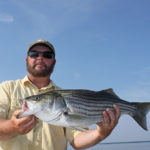
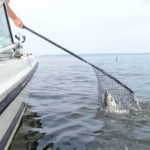
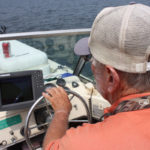
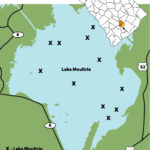




Be the first to comment